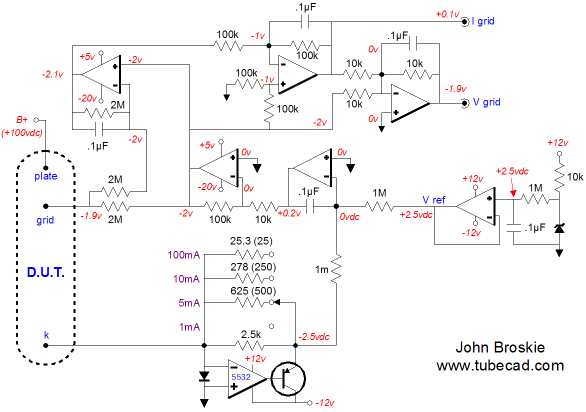| John Broskie's Guide to Tube Circuit Analysis & Design |
07 March 2009
TCJ 10 Year
Anniversary
So here I am, as Thomas Stearns E. might have put it, in the middle way, having had ten years—ten years largely wasted, the years of l'entre deux enfants terribles. Trying to use words to describe circuits, and every attempt is a wholly new start, and a different kind of failure. Because I have only learned to get the better of words for the circuits I no longer wish to explicate, or the way in which I am no longer disposed to say it. And so each blog entry is a new beginning, a raid on the enigmatic, with shabby equipment always deteriorating in the general mess of imprecision of high-end audio—undisciplined squads of fabricated rumor, advertising myths, and science most pseudo. And what there is to conquer, by acumen and acquiescence, has already been discovered once or twice, or several times, by men whom one cannot hope to emulate—but there is no competition—there is only the fight to recover what has been lost and found and lost again and again; and now, under conditions that seem unpropitious, but perhaps neither gain nor loss. For me, there is only the trying. The rest is not my business.
Tube Tester: Ig & Vg In the schematic above, we see three extra OpAmps. With these OpAmps we can extract the voltage drop across the two 2M resistors that attach to the grid. Now, 2M in parallel with 2M equals 1M, so any voltage that develops across these resistors will reveal a current flow equal to V/1M. Thus, for example if we measure 2V, then 2/1000000 milliamperes of current flows through the 1M resistance. In addition, this circuit allows us to measure the exact voltage at the grid, without dragging down that voltage in the process of measuring. The four-position switch allows us to set the desired idle current. At the first position, there is no resistor and the NE5532 OpAmp sees only the 2500-ohm feedback resistor. At the second position, the 625-ohm resistor is in parallel with the 2500-ohm resistor, which means that the OpAmp effectively sees 500-ohm feedback resistor. Because the auto-bias circuit will strive to maintain an output voltage of -25Vdc for the bottommost OpAmp, the current flowing through the feedback resistor (and by extension, the tube under test) must equal 2.5/Rfb. Thus, for example, 2.5/500 equals 5mA. The voltage reference is made up from a buffered voltage-reference IC, whose set voltage is 2.5V. To be honest, the RC filter that following the voltage reference is just so much extra frosting and it can be left out. One last feature worth mentioning is that while most of the OpAmps see a +/-12V power supply, the two OpAmps closest to the grid work off of +5V and -20V rails. Why? The tester needs to be able to control a wide range of tubes, so extra negative grid bias voltage is needed and at no time should we expect a tube to need positive grid bias. At the time I designed this tester, I preformed a survey of output tubes and I concluded that with only 150Vdc for a cathode-to-plate voltage all the tubes would be able to idle at 100mA with a grid voltage not less negative than -19V; perhaps I was wrong. More testing is required.
Next Time Since I began with T.S. Eliot, maybe I should end with what my fellow Capricorn, Henry Miller might have written about the Tube CAD Journal: What is this then? This is not a tube-Wiki website. This is useful, original, sonically sound. This is not an electronics website, in the ordinary sense of the word. No, this is a prolonged cheat sheet, a gob of hot solder in the face of high-end audio, a kick in the pants to proprietary circuits, Audio Research, Conrad Johnson, VTL, MJ, AudioXpress… what you will. I am going to spill the beans for you, a little sloppy perhaps but I will spill.
//JRB
|
Kit User Guide PDFs
E-mail from GlassWare Customers
High-quality, double-sided, extra thick, 2-oz traces, plated-through holes, dual sets of resistor pads and pads for two coupling capacitors. Stereo and mono, octal and 9-pin printed circuit boards available. Aikido PCBs for as little as $24 http://glass-ware.stores.yahoo.net/
Support the Tube CAD Journal TCJ Push-Pull Calculator
TCJ PPC Version 2 Improvements Rebuilt simulation engine *User definable
Download or CD ROM For more information, please visit our Web site : To purchase, please visit our Yahoo Store:
|
|||
| www.tubecad.com Copyright © 1999-2009 GlassWare All Rights Reserved |


























